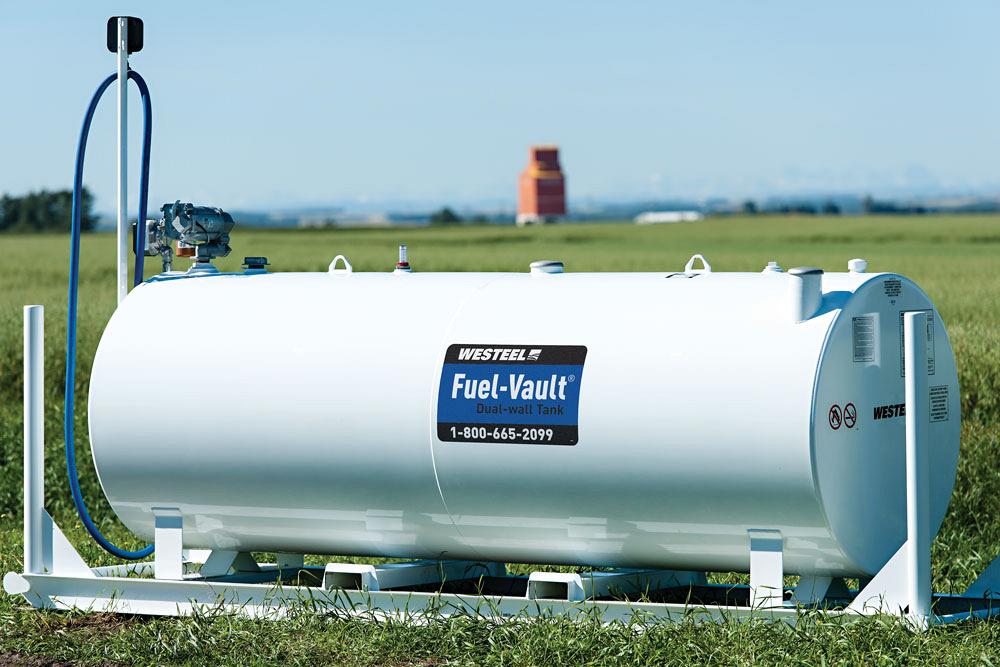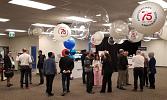Editor
- FMA
- The Fabricator
- FABTECH
- Canadian Metalworking
Automation reinvigoration
Westeel’s Olds, Alta., facility gets flexible with automated plate rolling and welding investments
- By Rob Colman
- July 24, 2017
- Article
- Fabricating
Sometimes it is the need to upgrade one machine that leads shop owners to discover how much they can gain from upgrading and automating various processes on the floor. The team responsible for Westeel – Ag Growth International’s Olds, Alta., facility is a case in point. Since replacing a very old plate roller with a four-roll CNC model with an automated feeding system, the shop has found other automation opportunities in its welding and cutting processes.
Westeel, founded in 1905, has its headquarters in Winnipeg. The company is known for its expertise in storage systems for grain, fertilizer, and fuels. Each of its facilities across the prairies specializes in different aspects of the storage business. For instance, the company’s Tisdale, Sask., facility specializes in large bulk storage tanks for the petroleum industry. The tanks it fabricates range in capacity from 15,000 litres to 200,000 litres.
Olds, which opened in 1998, also focuses strictly on the fuel industry, but its specialty is tanks that are 11,000 l or smaller. The shop typically works in hot-rolled steel pickled in oil in gauge thicknesses. It also works in plate steel.
“We have a pretty vast catalogue of standard products,” said Jason Hawman, operations manager for the Olds facility. “These range from cylindrical single-wall and double-wall products that go on farms to Transport Canada-rated slip tanks that you see on the backs of trucks in construction and farm use. We also work extensively for the upstream and downstream oil and gas industry.”
The shop also produces a line of home heating tanks. Although most of the company’s market share is in British Columbia, Alberta, Saskatchewan, and Manitoba, the home heating line is driving the company’s interests further east.
According to Hawman, the company prides itself on being responsive to customers’ needs. “Whereas some of our competitors may not be able to react to a request for an extra fitting or a different location for their fittings, for instance, we can do that,” he explained. “We can do off-the-wall configurations of our standard product, while also delivering quality. We are really trying to emphasize our flexibility while maintaining our high standards of quality and service.”
One-off Plate Rolling Capabilities
The claims Hawman makes for Westeel’s Olds production are based on the quality of the fabricating and welding talent on the shop floor, but also the upgrades the company has made recently that make the production of a clean, repeatable product easier to realize. The company is set up to do much of its own fabricating on its press brakes, shears, saws, specialized welding equipment, and a powder coat line. The only thing handled off-premises is the initial cutting to length of the steel used in production.
But some of the equipment the facility runs has become dated. For instance, until just over two years ago, the Olds facility used a 1950s-era Webb plate roller, a standard pyramid-style roller with openings the team had to hand-crank to get product through.
“You can appreciate that even though we do have standard parts, we do have a variety of different diameters, anywhere between 30 and 63 in.,” noted Hawman. “Also, the various gauges would have to be accounted for as well. So because of the age of the equipment, we were set up to do large-quantity runs of products. The setup was very cumbersome. Also, we would often have to scrap the first piece, and put in a lot of extra hours to ensure the setup was perfect. To get the full value out of the roller, we really had to run maybe 25 parts through it before resetting it for another part. This made it hard to be reactive for customers.”
The replacement the shop invested in is a Faccin 4HEL four-roll pyramidal electronic bending roll. This plate roller series is designed to bend plates with widths between 1,500 and 18,000 mm (5 and 60 ft.) and cold rolled steel from 5 to 150 mm (3/16 to 6 in.).
Westeel purchased the roll with a horizontal feeding table so that, in concert with the CNC system, sheets can be loaded and processing can be pretty much hands-off from there.
“The operator initiates the program and then can leave the station to do something else, if necessary,” said Hawman. “He only has to return to remove the finished product from the roller – that is still a manual process, for safety reasons.”
Improved Assembly
The speed and quality gains that have come from CNC programming and the automatic feeding process have made it possible for Westeel to run one-offs as easily as it does lot sizes of 25. And Hawman said that rejected parts have dwindled to next to nothing.
The other big difference the new roller made was in the inevitable flat that exists at the beginning of a roll with any rolled product. With an older three-roll machine, that flat is going to be fairly substantial.
“With our old machine, we would have around 3 in. of flat on every cylinder we rolled,” said Hawman. “Our customers didn’t care because they were getting that for many years and didn’t really notice. But from an assembly standpoint, that was really problematic for us. The four-roll system basically eliminates that. It makes the flat spot twice the width of the material thickness. When you are dealing with gauge, it’s almost zero.”
Hawman said that eliminating the flat made it possible to speed up assembly processes and helped improve the aesthetics of the tanks.
Welding Cell Speed
The plate roller ended up being a launching point for the Olds facility, according to Hawman.

Setting up the company's automated welding cell. Having the weld cell and plate roller has opened up new opportunities for the Westeel team in Olds.
“If the roller was from the ‘50s, there were probably two or three other pieces of equipment that were as old. It really made us think about what we wanted to do next and raised the bar for what that might be,” he explained.
The next investment was a custom-configured Jetline welding lathe with seam tracking.
“Tank bodies come off the roller and we put them in a brand-new assembler setup we built ourselves,” said Hawman. “We then put that in the welding lathe cell. There are three welding heads on the lathe that perform submerged arc welds on the tanks. The operator sets up the welding heads, initiates the program, and it automatically welds three seams at once.”
The welding power sources for this system are Lincoln PowerWave AC/DC machines.
“When you are welding thin gauge using submerged arc, alternating current technology is the cat’s meow,” said Hawman. “It is easy to set the current to your needs, so if we are welding 12 gauge, for example, you can just adjust the current down to allow more deposition and less penetration, thereby making sure you’ve got less potential for fall-throughs, which require repairs down the line. Introducing alternating current has probably been the biggest thing we’ve done to improve our weld quality in recent years.”
It’s possible for Westeel to put a tank as large as 63 in. diameter by 14 ft. long on this lathe, which accounts for about 90 per cent of the goods produced at the Olds location. The seams on the circumference are fully automated, whereas the longitudinal welds are only partly automated.
Employee Engagement
Hawman doesn’t mince words when he talks about how valuable these investments have been for his team.
“I think it has probably saved us in a difficult market,” he explained. “We have been able to adjust and improve our costing to become more competitive in our markets. And in terms of staffing, it hasn’t forced anyone out the door. We have repurposed some jobs and specialized others for the demands of the technology. And as the market improves, we are well-prepared to handle larger volumes.”
The new investments have affected employees in a positive way. For example, when the roller came into the shop, the night shift operators actually experimented with it and came up with some cost savings for a product that wasn’t even expected to run on the machine – an obround tank that in the past had been formed using other means.
“The guys surprised me one morning when I came in with this perfectly obround shell, and they hadn’t created any scrap parts in the process; they just played with the program,” Hawman recalled. “We were able to shave a good amount of cost from that product, and it is now a better-looking product as well.”
And the main operator for the welding cell was formerly running a saw at the facility.
“He isn’t even a welder,” said Hawman. “Welders often want to get their hands onto a project, and sub-arc doesn’t work that way. This guy is nice and patient, which is what you need in this type of setup. He is invaluable to us now.”
Not only are employees becoming more engaged as processes become more automated, but the level of safety in the shop has inevitably improved. Westeel has always encouraged safety in the workplace, but the type of equipment on the floor makes it easier to remain safe.
“We have been able to show our staff that we are serious about their safety through investing in new equipment,” said Hawman. “We pride ourselves on having a culture of safety and quality and look to always empower and engage our staff. These investments have been a large contributor to supporting that culture.”
At this point Hawman is cautious about saying too much about further investment plans at the Olds facility, but they are coming.
Editor Robert Colman can be reached at rcolman@canadianfabweld.com.
Westeel, 888-937-8335, www.westeel.com
Faccin Group, +39 030 67 29 300, www.faccingroup.com
Jetline Engineering, 949-951-1515, www.jetline.comAbout the Author

Rob Colman
1154 Warden Avenue
Toronto, M1R 0A1 Canada
905-235-0471
Robert Colman has worked as a writer and editor for more than 25 years, covering the needs of a variety of trades. He has been dedicated to the metalworking industry for the past 13 years, serving as editor for Metalworking Production & Purchasing (MP&P) and, since January 2016, the editor of Canadian Fabricating & Welding. He graduated with a B.A. degree from McGill University and a Master’s degree from UBC.
subscribe now


Keep up to date with the latest news, events, and technology for all things metal from our pair of monthly magazines written specifically for Canadian manufacturers!
Start Your Free Subscription- Industry Events
MME Saskatoon
- May 28, 2024
- Saskatoon, SK Canada
CME's Health & Safety Symposium for Manufacturers
- May 29, 2024
- Mississauga, ON Canada
DiPaolo Machine Tools Open House 2024
- June 4 - 5, 2024
- Mississauga, ON Canada
FABTECH Canada
- June 11 - 13, 2024
- Toronto, ON Canada
Zoller Open House & Technology Days 2024
- June 12 - 13, 2024
- Ann Arbor, MI






















